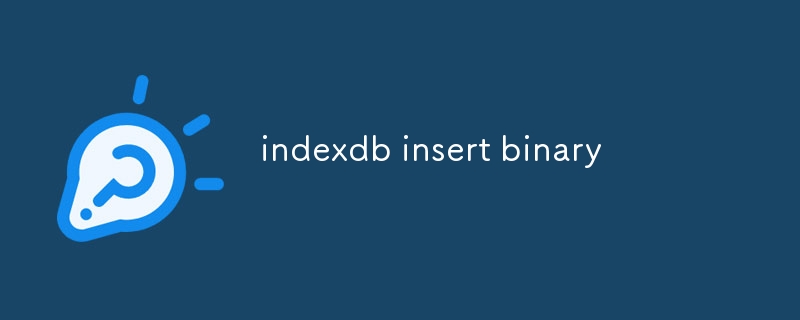indexdb insert binary
This article provides a comprehensive guide to efficiently insert binary data into IndexedDB. It outlines step-by-step instructions for converting binary data to an array buffer, creating an object store, transaction, and object, setting the object's

How to efficiently insert binary data into IndexedDB?
IndexedDB is a powerful data storage API that can be used to store various types of data, including binary data. To efficiently insert binary data into IndexedDB, follow these steps:
1. Convert your binary data to an array buffer: IndexedDB works with ArrayBuffer objects, so you need to convert your binary data to an array buffer first. You can use the ArrayBuffer.from() method for this purpose.ArrayBuffer.from() method for this purpose.
2. Create a new IndexedDB object store: An object store is a container for data in IndexedDB. You need to create a new object store to store your binary data.
3. Create a new IndexedDB transaction: A transaction is a unit of work in IndexedDB. You need to create a new transaction to insert your binary data.
4. Create a new IndexedDB object: An object is a representation of a record in IndexedDB. You need to create a new object to store your binary data.
5. Set the value of the object to the array buffer: The value of an object can be set to an array buffer. Set the value of your object to the array buffer that you created in step 1.
6. Add the object to the object store: Add the object to the object store that you created in step 2.
7. Commit the transaction: Once you have added the object to the object store, you need to commit the transaction to save the changes.
Example:
// Create an array buffer from binary data
const buffer = ArrayBuffer.from(binaryData);
// Create a new object store
const store = db.createObjectStore("myBinaryData", { keyPath: "id", autoIncrement: true });
// Create a transaction
const transaction = db.transaction(["myBinaryData"], "readwrite");
// Create a new object
const object = transaction.objectStore("myBinaryData").create({});
// Set the value of the object to the array buffer
object.value = buffer;
// Add the object to the object store
transaction.objectStore("myBinaryData").add(object);
// Commit the transaction
transaction.commit();Can I use IndexedDB to store images as binary objects?
Yes, you can use IndexedDB to store images as binary objects. To store an image as a binary object in IndexedDB, follow these steps:
1. Read the image file as an array buffer: Use the FileReader
2. Create a new IndexedDB object store: An object store is a container for data in IndexedDB. You need to create a new object store to store your binary data.
3. Create a new IndexedDB transaction: A transaction is a unit of work in IndexedDB. You need to create a new transaction to insert your binary data.
4. Create a new IndexedDB object:
An object is a representation of a record in IndexedDB. You need to create a new object to store your binary data.5. Set the value of the object to the array buffer:
The value of an object can be set to an array buffer. Set the value of your object to the array buffer that you created in step 1.6. Add the object to the object store:
Add the object to the object store that you created in step 2.7. Commit the transaction:
Once you have added the object to the object store, you need to commit the transaction to save the changes.Example:
🎜rrreee🎜Can I use IndexedDB to store images as binary objects?🎜🎜🎜Yes, you can use IndexedDB to store images as binary objects.🎜 To store an image as a binary object in IndexedDB, follow these steps:🎜🎜🎜1. Read the image file as an array buffer:🎜 Use theFileReader API to read the image file as an array buffer.🎜🎜🎜2. Convert the array buffer to a base64 string:🎜 IndexedDB does not support storing array buffers directly. You need to convert the array buffer to a base64 string before storing it in IndexedDB.🎜🎜🎜3. Insert the base64 string into IndexedDB:🎜 Insert the base64 string into IndexedDB using the steps outlined in the previous section.🎜🎜What are the limitations of storing binary data in IndexedDB?🎜🎜🎜There are some limitations to storing binary data in IndexedDB:🎜🎜🎜🎜1. Size limit:🎜 IndexedDB has a size limit of 2^31-1 bytes per database. This means that you can't store more than 2 GB of binary data in a single IndexedDB database.🎜🎜🎜2. Performance:🎜 Storing binary data in IndexedDB can be slower than storing other types of data, such as strings or numbers. This is because IndexedDB needs to convert the binary data to a base64 string before storing it, which can be a time-consuming process.🎜🎜🎜3. Compatibility:🎜 IndexedDB is not supported by all browsers. This means that you may not be able to use IndexedDB to store binary data in all browsers.🎜The above is the detailed content of indexdb insert binary. For more information, please follow other related articles on the PHP Chinese website!

Hot AI Tools

Undresser.AI Undress
AI-powered app for creating realistic nude photos

AI Clothes Remover
Online AI tool for removing clothes from photos.

Undress AI Tool
Undress images for free

Clothoff.io
AI clothes remover

AI Hentai Generator
Generate AI Hentai for free.

Hot Article

Hot Tools

Notepad++7.3.1
Easy-to-use and free code editor

SublimeText3 Chinese version
Chinese version, very easy to use

Zend Studio 13.0.1
Powerful PHP integrated development environment

Dreamweaver CS6
Visual web development tools

SublimeText3 Mac version
God-level code editing software (SublimeText3)

Hot Topics
 1377
1377
 52
52


